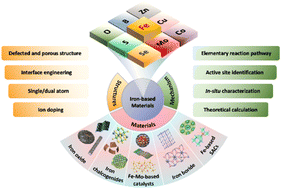Ammonia (NH3) is the most important chemical and carbon-free energy carrier, which is currently mainly produced by the energy-intensive Haber–Bosch process at high temperatures and pressures. In the spirit of global carbon neutrality and sustainable development, electrochemical nitrogen reduction reaction (NRR) is expected as a promising alternative to the traditional Haber–Bosch process for industrial ammonia production due to both low energy consumption and zero emission of carbon dioxide. However, further breakthroughs in electrochemical NRR strongly depend on the efficiency and selectivity of electrocatalysts. The element Fe has been found to be an important component in nitrogenase enzymes, generating extensive research interest. As one of the most cost-effective and abundant transition metals, iron-based materials have presented great potential for electrochemical NRR. In this review, we summarize recent advances in iron-based materials (including its oxides, chalcogenides, borides, single Fe-atom catalysts, and bimetallic catalysts especially for Fe–Mo-based compounds) towards highly efficient N2-to-NH3 conversion under ambient conditions. Based on recent theoretical and experimental studies, we focus on the structure–property relationship. Strategies to boost NRR performances and perspectives for future developments are comprehensively presented in synthetic protocols, structure modification, activity/selectivity enhancement, and reaction mechanisms to provide insightful guidance for the field of NRR studies.

